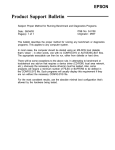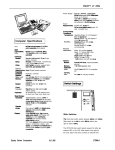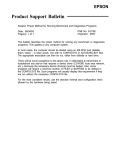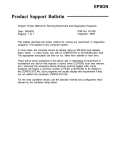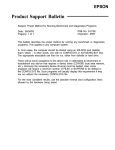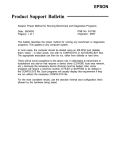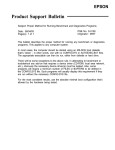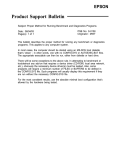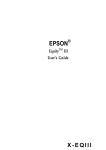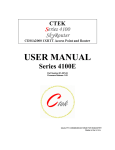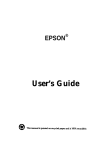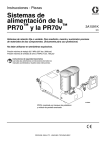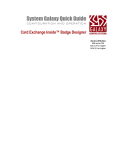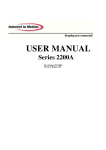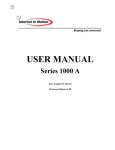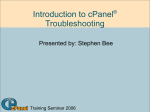Download Epson Equity LT Product Support Bulletin
Transcript
EPSON Product Support Bulletin Subject: Proper Method for Running Benchmark and Diagnostics Programs Date: 06/04/93 Page(s): 1 of 1 PSB No: S-0158 Originator: MWT This bulletin describes the proper method for running any benchmark or diagnostics programs. This applies to any computer system. In most cases, the computer should be started using an MS-DOS boot diskette that’s ‘clean’ - in other words, one with no CONFIG.SYS or AUTOEXEC.BAT files. The appropriate executable can then be run, either from diskette or hard drive. There will be some exceptions to the above rule. In attempting to benchmark or troubleshoot any add-on that requires a device driver (CD-ROM, local area network, etc.), obviously the necessary device driver(s) must be loaded. Also, some programs will require a minimum number of FILES or BUFFERS to be defined in the CONFIG.SYS file. Such programs will usually display this requirement if they are run without the necessary CONFIG.SYS file. For the most consistent results, use the absolute minimal boot configuration that’s allowed by the hardware being tested. Product Support Bulletin Subject: Equity LT Battery Life and the AdaptaPAK Battery Pack Date: Page: 9/7/89 1 of 2 S - 0096 PSB No.: Originator: BGB (-7 ;i4 The purpose of this bulletin is to provide the test results of the Product R&D’s AdaptaPAK Battery and usage instructions. Like the Equity LT’s internal battery, (refer to PSB S- 0055) there are several usage variables that can have a significant effect on the working time. In this test, the Equity LT was configured with the 20MB hard disk drive and the EL (electroluminescent) backlit LCD and set at 10 Mhz. This is the most popular configuration and also the one that consumes the most power. The first test was with heavy access, constantly using the hard disk and floppy disk. The internal battery was previously discharged. The laptop and AdaptaPAK battery were charged for 18 hours. The battery charge lasted a total of 5 hours and 15 minutes before it ceased operation. The second test was with minimum access and the hard drive turned off after powering on. The internal battery was previously discharged. The Equity LT and the AdaptaPAK battery were charged for 18 hours. After turning on the unit, a program that didn’t require any keyboard input was executed. The battery charge lasted a total of 8 hours and 15 minutes before it ceased operation. NOTE: The battery lives listed in this document are the results of our tests. Your experience may vary as battery life is affected by configuration and usage. We can also assume that if we were to follow the guidelines (PSB S-0055, P3) to extend the battery charge time, we would get even better results. AdaptaPAK Battery 1) Ensure the battery is fully charged before using. approximately 10 hours. Full charge takes 2) The battery is a sealed lead - acid type. 3) The battery is contained in a black nylon carrying case with shoulder strap. 4) It plugs into a 120V AC outlet for charging. international 220V AC recharger is available. For overseas usage an PSB No: S-0096 Page: 2 of 2 5) Weight 7 Ibs, size 3 X 6 X 11 inches. The product is manufactured and available from: Product R&D Corporation 1194 Pacific St., Suite 201 San Luis Obispo, CA 93401 Phone: (805) 546 - 9713 The AdaptaPak product includes the ExtraPAK battery and AdaptaCORD. Both are required for use with the Equity LT. Epson Accessories, Inc. is considering the possibility of offering the AdaptaPAK for resale. PSB No.: S-0062I Page: 1 of 18 EISA SERIES DESKTOP VER PART # 0.10.20.01 DESKROM DESC Phoenix TYPE LOC 27C512 REASON U26 INITIAL RELEASE EISA SERIES TOWER VER PART # TOWERROM DESC TYPE LOC U26 REASON INITIAL RELEASE EQUITY LT VER 1.00 1.00 1.01 1.01 PART # Y164802001 Y164803001 DESC TYPE HLO-A1 HLO-B1 HLO-A2 HLO-B2 27C64 27C64 27C64 27C64 LOC 3F 5F 3F 5F REASON INITIAL RELEASE (FIRST 800 UNITS) Fixes problems with the serial port and Microsoft Word. EQUITY LT286e VER 1.01 1.01 PART # DESC TYPE AMI AMI 27256 27256 LOC U18 U19 REASON INITIAL RELEASE EQUITY LT386SX VER 1.02 1.02 PART # DESC AMI AMI TYPE 27C256 27C256 LOC U13 U14 REASON INITIAL RELEASE NB3s VER 040990-KO PART # DESC TYPE LOC REASON INITIAL RELEASE EPSON EPSON AMERICA, INC. PRODUCT SUPPORT BULLETIN SERVICE DATE: PSB NO.: S-0055 SUBJECT: EQUITY LT BATTERY PAGE: 1 of 4 6/14/88 LIFE bulletin is to provide additional The purpose of this battery charge life with the Equity LT. information regarding There are several variables that can have a significant effect on the working time obtainable from a charge. These include: Configuration I/O activity Battery condition Processor speed Environment Configuration One of the more popular configurations of the Equity LT is the hard disk drive model with the EL (electroluminescent) backlit that will LCD. Obviously, this is the configuration also shortest working time consume the most power and provide the on a charge. For example, here are some comparisons between various configurations: CONFIGURATION LOW BATTERY Dual Dual Dual Dual HDD, HDD, HDD, HDD, 6:00 1:20 5:20 0:55 4:00 0:45 3:45 0:25 Hours Hours Hours Hours Hours Hours Hours Hours FDD, Reflective LCD (NA) FDD, Reflective LCD (FA) FDD, Backlit LCD (NA) FDD, Backlit LCD (FA) Reflective LCD (NA) Reflective LCD (FA) Backlit LCD (NA) Backlit LCD (FA) TOTAL 7:00 1:50 6:lO 1:20 4:40 1:05 4:20 0:40 LIFE Hours Hours Hours Hours Hours Hours Hours Hours NA = No access: No activity including no keyboard input FA = Full access: "COPY A:*.* B:" or "COPY A:*.* C:" (These times configuration are and a representative sampling. Depending usage, your times may vary.) It's apparent that drive effect on working time. EPSON AMERICA SERVICE, and 23610 backlight TEL0 usage AVENUE, has a TORRANCE, on dramatic CALIF. 90505 I NUMBER: S-0055 PAGE: 2 of 4 RGB monitor ports can serial or Heavy use of the parallel, this is of less time. Functionally, reduce working also these ports via interface because devices that concern (with the exception of battery-powered printers and modems) will require AC power, allowing access to the LT's AC adapter. Battery Condition "memory". exhibit a phenomenon known as All NiCad batteries number of times if the battery is recharged a Essentially, the shorter "remembers" without being fully discharged, it times between charges. This is why you will see photographers units before putting them discharge their electronic flash away. Processor Speed which is a low-power The Equity LT employs the NEC V30 CPU, the 10 MHz speed However, CMOS 8086-compatible processor. In fact, setting will cause it to draw somewhat more power. the difference on a dual FDD LT with the reflective LCD, 48 minutes total between 4.77 and 10 MHz can be as much as life. Environment not only can effect Extremes in temperature and humidity battery charge life, but LCD performance as well. The standard rule of thumb applies here: If it's comfortable for you, your computer should function optimally. I NUMBER: S-0055 PAGE: 3 of 4 How to get the most out of the Equity LT battery charge It is possible to extend the working the Equity LT by following a few simple guidelines: time of 1) Turn the hard disk drive power OFF. For most applications, constant access to the hard disk drive is not required. wait for the Once the application is loaded into RAM, HDD power switch drive access LED to go out and turn the turn the HDD off. When you're ready to save your work, power switch back on, wait for the HDD to spin up and then save. Another alternative is to boot the LT from floppy self-test will take with the HDD power off. The power-on longer, and a "1701-C" error will display. This is normal Then you can this situation and ignored. should be l:cess your application from the FDD. This is 2) Set the backlight period to 0.5 minutes. accomplished from the SETUP program. If you pause to think about what you're doing, the backlight will turn off after 30 seconds. This drops power consumption by as much as 580mA. Also, set the brightness and contrast controls as low as is between 1/2 comfortable. The difference brightness and full brightness can be as much as 445mA. consumption 3) Run at 4.77 MHz. The difference in power between 4.77 MHz and 10 MHz is 70-80mA. 4) Completely discharge the battery. From time to time, let the battery drain all the way down. When the LOW BATTERY (if any) LED starts flashing, save your work in progress the power and then leave the LT powered up. Eventually, supplied by the battery will drop below the threshold level and the system will power down. Then give it a full (12 hour) recharge. This will help to minimize the memory effect. I NUMBER: 5) PAGE: S-0055 4 of 4 Traveling Software has recently introduced a battery package called monitoring maintenance software and Battery Watch. This package has been written specifically including the for a number of popular laptop systems, Equity LT. Battery Watch provides the capability to: Monitor battery life Customize the Perform "deep a (and optionally set an audible alarm) installation discharge" of the NiCad It's a small (10-20KB) memory-resident information, please contact: battery program. For more Traveling Software, Inc. 19310 North Creek Parkway Bothell, Wa. 98011 (206) 483-8088 it is possible to achieve By following the above guidelines, working times well in excess of two hours with a hard drive, backlit Equity LT. I EPSON EPSON AMERICA, INC. PRODUCT SUPPORT SERVICE PSB NO.: S-0053 SUBJECT: EQUITY BULLETIN PAGE: 1 of 1 DATE: 6/1/88 I+/II+/III+/LT DIAGNOSTIC "EXEC failed" MESSAGE The purpose of this bulletin is to clarify the correct usage of the DIAGNOSTIC DISK. Many customers and dealers have contacted Epson's Technical Support because of getting a "EXEC failed" error message when trying to run the system diagnostics MEMORY test. This occurs because many people are not booting the system with the diagnostic disk but rather loading the diagnostic program after booting from the MS-DOS system disk or hard disk drive. In the instructions for performing system diagnostics the following statement is made: Note: To run the System diagnostics, boot your system with the diagnostics diskette in drive A. Then select option 4 from the OPERATION menu. If you start this program in any other way, some tests may produce strange results. The "EXEC failed" error message will not occur if the diagnostic diskette is properly loaded, Please note that the diagnostic diskette should not modified in any way or similar results may occur. be If the diagnostics diskette was obtained through Epson America's Training Department and does not contain the system files then the system files should be copied to the diagnostics disk before attempting to run the diagnostic programs. L EPSON AMERICA SERVICE, 23610 TEL0 AVENUE, TORRANCE, CALIF. 90505 Product Support Bulletin Subject: Using Expanded Memory with Equity and Apex Computers Date: Page: 3/2/90 1 of 6 Q1. A. Q2. A. PSB No: Originator: S-0047C KAS ‘/“p& What is Expanded Memory? Conventional memory, managed by MS - DOS, is limited to 640K. In response to the need for greater amounts of accessible memory, the LIM EMS (Lotus/Intel/Microsoft Expanded Memory Specification) was introduced in 1984. EMS, version 3.2, provides usable memory beyond the 640K limit through “bank switching”. The expanded memory is divided into 16K portions called “pages”. The computer accesses these pages through a “page frame” or “window” which is 64K of memory located between 768K and 896K in 80286 - based systems and between 800K and 960K in 8086 - or 8088 - based systems. 16K pages of memory are allocated for an application’s use and the EMM (Expanded Memory Manager) handles the job of mapping the pages in and out of the page frame as they are needed. However, in order to make use of expanded memory, the software must be written to take advantage of the EMS. Software such as Lotus 1 - 2 - 3, Microsoft Windows and Borland’s SideKick Plus make use of expanded memory. EMS is limited to 8Mb of expanded memory. What is EEMS? A superset of EMS, AQA EEMS (AST/Quadram/Ashton - Tate Enhanced Expanded Memory Specification) provides greater flexibility in the mapping of expanded memory. However, it also uses the technique of “bank switching” and has its own memory manager which accommodates such specially written software as Quarterdeck’s DESQview. EEMS is also limited to 8Mb of expanded memory. PSB No: S-0047C Page: 2 of 6 Q3. A. Q4. A. Q5. A. What about the 155Mb RAM listed as the maximum for the Equity III +? This larger amount of RAM is the maximum usable memory range for an 80286 microprocessor and generally refers to extended memory. Extended memory starts at the 1Mb boundary and extends out to 16Mb. As it requires a 24 - bit address to access memory in this range, extended memory is handled by the protected mode of the 80286. Examples of currently available software that can switch into protected mode to use extended memory are Framework II, AutoCAD, the VDisk RAM disk and Xenix OS. How does LIM EMS 4.0, the latest version, differ from the earlier version, LIM EMS 3.2? EMS 4.0 supports up to 32Mb of expanded memory where EMS 3.2 supported only 8Mb. EMS 4.0 has been changed to make it easier for applications to share expanded memory. In EMS 4.0, page mapping has been streamlined and new functions allow application programs to dynamically increase and decrease the amount of expanded memory allocated to them. In previous versions of EMS, the page frame was located in an unused 64K block of memory between 640K and 1Mb. EMS 4.0, subject to limitations in the system hardware, supports the page frame anywhere in the first 1Mb of memory. Before EMS 4.0, the page frame held four pages. Now you can define a page frame of up to eight pages in memory above 640K. The size of the page frame is limited only by the amount of available memory. There has also been a change to support the smaller than standard (16K) memory pages used by some expanded memory boards. Is EMS 4.0 compatible with my old expanded memory board? The EMM 4.0 driver works with existing hardware. You don’t need to buy a new expanded memory board. However, until you use applications that have been written to take advantage of EMS 4.0, you probably won’t notice much improvement in performance over your older version. PSB No: S-0047C Page: 3 of 6 Q6. What memory expansion boards are compatible with the Equity I and Equity II? A. The following boards have been tested by Epson in the Equity I and II: All Card w/MMU Multifunction Liberty PC Mini Magiccard (EV - 138) AST SixPak Premium AST Rampage All Computers, Inc. Quadram Corporation Everex Systems, Inc. AST Research AST Research Q7. What memory expansion boards are compatible with the Equity Ill? A. The following boards have been tested by Epson in the Equity Ill: Grande Byte Intel Above Board AT Liberty AT AST Advantage AST Rampage AT AST Ramvantage STB Systems Intel Corporation Quadram Corporation AST Research AST Research AST Research Q8. What memory expansion boards are compatible with the Equity I +? A. The following boards have been tested by Epson in the Equity I +: 64/256KB Expansion Option Above Board PC (1985) Fastcard IV (1.6) IBM Intel Corporation Thesys Q9. What memory expansion boards are compatible with the Equity le? A. The following boards have been tested by Epson in the Equity le: 64/256KB Expansion Option Quad Board II Fastcard IV RAMpage IBM Quadram Thesys AST Research Note: The Intel Above Boards do not currently operate reliably with the Equity le. PSB No: S-0047C Page: 4 of 6 Q10. What memory expansion boards are compatible with the Equity II + and Equity Ill + (10MHz models)? A. The following boards have been tested by Epson in the Equity II + and Equity Ill + (10MHz models): Advantage Premium Rampage 286 * Above Board 286 Above Board 286 p/s * Grande Byte * Rio Grande Elite 16 AST Research AST Research Intel Corporation Intel Corporation STB Systems STB Systems Profit Systems * Will run at 8MHz, not at 10MHt. Q11. What memory expansion boards are compatible with the Equity II + and Equity Ill + (12MHz models)? A. The following boards have been tested by Epson in the Equity II + and Equity III + (12MHz models): Rampage 286 Plus Elite 16 Above Board Plus AST Research Profit Systems Intel Corporation NOTE: Previously boards from Micron Technology were listed as compatible with the 12MHz models of the Equity II + and Equity Ill +. They have been removed from the list because Micron no longer produces ISA memory boards. Q12. A. How do you expand the memory of the Equity 386/20? Memory expansion in the Equity 386/20 can be accomplished by adding SlMMs (single in - line memory modules) to the CHET - RM board. Both 256K and 1Mb SlMMs are available from Epson America. The 256K SlMMs are sold in 1Mb kits and the 1Mb SlMMs are sold in 2Mb kits. Compatible third party 1Mb SlMMs are available from Matsushita, Toshiba and CDC Enterprises. You can also use third party memory expansion boards such as those listed above for the Equity II +/Ill +. PSB No: S-0047C 5 of 6 Page: Q13. A. Are there any guidelines to installing the SlMMs in the Equity 386/20? Yes, when SlMMs are installed to increase memory beyond 1Mb, they must be installed so that banks of SlMMs are installed as matched pairs. See the matrix below: Memory Bank 0 1MB 2MB 4MB 4MB 8MB 10MB 16MB 4X256KB 4X256KB 4X256KB 4X1MB 4X1 MB 4X1 MB 4X1 MB Note: Bank 1 Bank 2 Bank 3 4X256KB 4X256KB 4X256KB 4X256KB 4X1 MB 4X1 MB 4X1 MB 4X256KB 4X256KB 4X1 MB 4X1 MB Refer to PSB S - 0095 for 18MB RAM Setup information. Q14. Is there a driver supplied with the Equity 386/20 to allow the use of the extended memory as expanded memory? A. Yes, the Equity 386/20 system software includes the device driver EEMM386EXE. This driver emulates LIM EMS 4.0 memory using the extended memory supplied by the additional SIMMs. It will support only the onboard memory above 1 MB, up to 15MB. This is the maximum memory that can be installed on the CHET- RM board. It will not support memory installed on memory expansion boards. Q15. Are there any expanded memory boards that are compatible with the Equity LT? A. No, the option slots on the LT require a special connector. The hard drive controller and the LT cartridge modem are the only option cards currently available from Epson America. Q16. What expanded memory boards are compatible with the Apex by Epson? A. The Above Board PC from Intel Corporation has been tested by Epson in the Apex. PSB No: S-0047C Page: 6 of 6 Q17. Are there any general guidelines for determining the chip speed to install on the memory expansion boards? A. Yes, if the CPU speed is 8MHz or less, use 150ns RAM chips. If the CPU speed is 10/12MHz, use 120ns RAM chips. Q18. Is there anything that should be kept in mind during the installation procedure for the memory expansion boards? A. Yes, when installing the memory boards in the Equity II + and Equity Ill + (12MHz models), remember that the bus speed is 12MHz. For example, the Intel Above Board 288 and Above Board Plus allow you to set up the bus speed and chip speed in their installation programs. Q19. What is meant by backfilling memory when using software such as DESQview? A. Backfilling is a function of many expanded memory boards which allows a portion of the board’s memory to be used as conventional memory. In this way, you could turn a 256K system into one with 840K memory or more. In certain situations, you may want to disable some of the computer’s conventional memory and the use the memory on the expansion board (i.e. DESQview). Q20. Which Epson computers have memory settings that allow backfilling memory? A. The Equity I, Equity I +, Equity II + and Equity Ill + allow backfill. The Equity I comes with 256K standard and the Apex comes with 512K, thus allowing backfill. The Equity I + has DIP switch settings allowing system memory to be disabled to 256K or 512K. The Equity II+ and Equity Ill + have jumpers on the system memory boards to allow memory to be disabled to 256K and 512K. EPSON EPSON AMERICA INC. SERVICE DEPARTMENT PRODUCT SUPPORT BULLETIN DATE: 02/25/88 PSB #: 0036 SUBJECT: Equity LT - Common Questions and Answers Q1. Can I switch the CPU speed between 4.77 MHz and 10 MHz while the L T is in operation ? A. Yes - the CPU and clock circuitry are fully synchronized. Q2. How can I adjust the speaker volume? A. You can’t. There is no provision, either hardware or software, for volume control. Q3. What type of keyboard is the LT keyboard compatible with? A. The LT keyboard is compatible with the “old-style” PC/XT 83-key keyboard. The only difference is the addition of the “SysReq” key and a second “Ctrl” key. Since the ROM BIOS is compatible with that of the “new-style” XT, support is provided for the “SysReq” key. The LT keyboard has two “Ctrl” keys, to the left and right of the space bar. Both keys return the identical scan code (1Dh), so it is not possible to distinguish between the left and right keys, as can be done with the enhanced AT-style 101-key keyboard. Q4. What is the shock resistance of the floppy and hard disk drives? A. Shock resistance of the FDD is as follows: Operation Non-operation 5G 50G Shock resistance of the HDD is as follows: Operation Non-operation Read Write 5G 3G 70G Equity LT - Common Questions and Answers - Page 1 of 9 Q5. Can I move my LT around while it is turned on ? A. With a dual-FDD LT, it should be okay to move it around as long as both drive access LEDs are off. Moving it in the middle of a disk access is definitely not recommended. With the hard disk model, the HDD motor is normally on, even if there is no drive access. Simply turn the HDD power switch (on the back of the LT) off. When you’re finished moving, turn the HDD power back on. Q6. How do I use a color CRT with my LT? A. Set DIP switch 4 (at the top of the keyboard) to the OFF position and connect the monitor to the connector labeled CRT on the back of the LT. The switch setting can be changed while the computer is turned on: However, some applications may not operate correctly. If this happens, turn the LT off, wait at least 5 seconds, then turn the power back on. This will assure correct operation. Q7. Can I use an EGA monitor with my LT? A. Certainly. It will work just like connecting an EGA monitor to a CGA card in a desktop PC - that is, you won’t get the high-resolution graphics and the denser character cell in text mode. Q8. Are the option slots compatible with the IBM PC/XT? A. The shape and size of the option slot connectors are different, so existing option cards cannot be used. However, the signal, data and power supply lines are the same as the PC/XT. Q9. Can third-party option cards be installed in the LT? A. Since the form factor of the connectors is unique to the LT, at present only the modem and hard disk controller made by Epson can be used. Q10. Can an 8087 be used? A. No, no socket is provided for a numeric co-processor. One of the main reasons is that an 8087 consumes a relatively high amount of power, which would adversely affect battery life. Equity LT - Common Questions and Answers - Page 2 of 9 Q11. What kind of mouse can I use? A. Just about any mouse can be used with the LT, provided it uses the RS-232C serial interface (like the Microsoft Serial-PS/2 Mouse). Q12. Can the amount of RAM memory be increased? A. No. Epson does not provide any memory expansion capabilities. Q13. Can I use a light pen? A. No. Even though the necessary I/O registers are present, there is no connector for the light pen. Q14. What kind of external FDD can use with the LT? A. The external FDD interface was designed to be compatible with the Toshiba laptops (such as the T1100+), so any external 5.25” FDD that works with a Toshiba will work with the LT. One such drive is the model NTHLPFL from the Nth Group in Canoga Park, California. Their phone number is (818) 883-5506. Q15. How many FDDs are supported by the LT? A. As with most laptops, the ROM BIOS will support two FDDs. Even if you have an external drive connected, you still can only access drives A and B. Q16. When an external FDD is connected to the LT, which drive letter should be assigned to the external drive? A. DIP switch 2 (on the back of the LT) determines whether the external drive will be A or B. Typically, you would assign it as A if you were using copy-protected software that requires a “key” disk, or running certain game programs that require booting from drive A. Otherwise, it’s a matter of personal preference. Q17. Is it possible to use a 360 KB and a 1.2 MB FDD? A. No. The LT supports a 250 KB per second transfer rate, so the 360 KB drive works fine. The 1.2 MB FDD uses a higher transfer rate and is, therefor, not compatible. Equity LT - Common Questions and Answers - Page 3 of 9 Q18. Can I install the HDD option kit myself? A. The installation procedure is very complex, and should only be performed by authorized servicers. Q19. Does the HDD automatically park the heads in the shipping zone when the LT is turned off? A. No, head parking is a little different on the LT. Approximately 5 seconds after the last HDD access, the heads are driven to the shipping zone and the drive access LED goes out. Whenever the LED is out, YOU may safely shut down. Never power off when the LED is on! Q20. Is it possible to perform a low-level (physical) format on the HDD? A. All LT HDDs are physically formatted at the factory before shipment, with any bad cylinders being properly mapped out. Users do not need to do a physical format themselves. For this reason, the HDFMTALL program is not included on the LT Reference Diskette. Q21. Why is there a separate power switch for the HDD? A. This feature conserves the charge of the built-in battery pack. When working without the AC adapter, you may want to turn off the HDD when you’re not using it, thereby prolonging battery charge life. The HDD (and fan) use considerably more power than the FDD. Q22. Can I turn off the HDD power switch after I've turned on the computer? A. Of course. You may turn the HDD power off either before or after turning the LT on. Q23. Can I access the HDD after the HDD power switch has been turned off? A. 1. If you turn the computer on as usual (HDD power on) and then power off the HDD, you may access the HDD after turning the HDD power on and waiting for the drive to spin-up. 2. If you turn the HDD power off and then turn the LT on, you will not be able to access the HDD at all, even if you turn it on later. Also, you will get a “1701C” after a lengthy boot-up, because the system’s CMOS configuration RAM is expecting to “find” the HDD. Equity LT - Common Questions and Answers - Page 4 of 9 Q24. What other HDDs can I use with the LT? Can I use an external HDD? A. Only the proper internal HDD from Epson can be used with the LT. Q25. How many HDDs can be used with the LT? A. Only one HDD is supported. LCD Displays Q26. Can I replace the EL (electroluminescent) element in the backlit LCD? A. Yes, you can. The replacement procedure is explained in Appendix A of the Equity LT User’s Guide. However, it can be a rather tricky operation and we strongly recommend that your dealer do the replacement. Q27. What is the expected lifetime of the EL element? A. The EL element, like any kind of light bulb, will gradually lose brightness. “Lifetime” for the EL element is defined as the time it takes for the element to fall to half of the original brightness. This works out to approximately 500 hours at maximum brightness. You can extend this period by adjusting the brightness down, keeping the EL only as bright as needed in order to see the screen clearly. Q28. What is the "backlight period"? A. This is another feature that extends the useful life of the EL element. You can set an option with the SETUP command to have the EL turn off after a period of no keyboard activity. You can set the time in half-minute increments from 0.5 through 5.0 minutes. You can also set “NO Time Limit” to cause the EL to remain on constantly. After the EL turns off, you turn it back on by pressing a key. The backlight period value is stored in system CMOS RAM. Q29. What is the aspect ratio of the LCD display? A. The aspect ratio for both LCDs is 1:1.4. (The aspect ratio needed to obtain true circles is 1:2.4.) Equity LT - Common Questions and Answers - Page 5 of 9._ _ _ . Q30. How are colors distinguished on the LCD display? A. Text mode In text mode, the CGA can display 16 colors (8 normal, 8 intensified), In LCD mode 3, 8 gradations are used for the 8 normal colors and the double-width font is used for the intensified colors. Note that in LCD modes 0, 1 and 2 that the colors are not distinguished. Intensity is represented by use of the double-width font or a halftone. Graphics mode CGA can display 4 colors at the same time in the 320 x 200 graphics mode. There are two methods available with the LCD display. Method 1 can display only 3 shades (4 simulated); Method 2 can display 4 shades. LCD modes 0 and 2 use Method 1; modes 1 and 3 use Method 2 and are thereby the better choice for displaying graphics. Q31. Why are there 4 LCD modes.? What are A. In LCD mode 3, 8 gradations and the double-width font are used instead of colors in text mode. However, it is difficult to read characters in a light shade or characters in which the foreground and background shades are similar. To resolve this, other LCD modes are provided. Roughly speaking, the differences in text mode (80 x 25 and 30 x 25) are as follows: the differences between them? Mode 0 A11 non-black characters use the white shade, with the double-width font being used for intensified characters. Mode 1 All non-black characters use the white shade, with halftone being used for intensified characters. Mode 2 All non-black characters use the white shade, with the double-width font being used for intensified characters. Mode 3 8 gradations are used for the 8 normal CGA colors. The double-width font is used for intensified characters. Q32. How long does it take to charge the battery pack? A. For full charge, it takes 12 hours when the LT is turned off. The battery pack cannot be overcharged, so it is perfectly safe to leave it connected for more than 12 hours. Also, remember that NiCad batteries need to be fully discharged from time to time for maximum effective life. So occasionally let the battery pack discharge to the point that the “Low Battery” LED comes on. Equity LT - Common Questions and Answers - Page 6 of 9 Q33. Is the battery being charged if I’m using the computer? A. Yes, the battery is being charged whenever you have the AC adapter connected. It will take longer to charge if the LT is turned on, however. Q34. Can I use any other AC adapter? A. NO! Use only the Epson adapter that comes with the LT. Q35. Can I use the adapter with 220/240 volts, as well 110/120? The adapter label says “100 - 120 VAC” for input. A. Yes, you can. The label was printed that way for the U.L. and C.S.A. regulatory agencies. You will probably need an adapter plug for the different wall sockets overseas. Q36. How long is the battery life ? How long can I use the LT after the “Low Battery” LED starts flashing? A. The following table shows the battery life for each configuration. The values are approximate. I Configuration I Term Full Access I No Access FDD model t Reflective LCD FC -> LB LB -> SD Total 1:20 0:30 1:50 FDD model t Backlit LCD FC -> LB LB -> SD Total 0:55 0:25 1:20 *1 *1 *1 5:20 0:50 6:10 *2 *2 *2 HDD model t Reflective LCD FC -> LB LB -> SD Total HDD model t Backlit LCD FC -> LB LB -> SD Total 0:25 0:15 0:40 *1 *1 *1 3:45 0:35 4:20 *2 *3 *2 *3 *2 *3 6:00 1:00 7:00 Full access: "COPY a:*.* b:" or "COPY a:*.* c:" No access: No activity, including no keyboard input. FC: Full charge LB: Low battery (when "Low Battery" LED starts flashing) SD: System down Equity LT - Common Questions and Answers - Page 7 of 9_____ *1 : Maximum backlight brightness *2 : Backlight turned off *3 : HDD switch turned off Q37. What are the differences in the ROM BIOS between the Equity LT and the Equity I+? A. The differences are: 1) The Equity LT ROM BIOS turns off the EL element of the backlit LCD if a specified time has passed without keyboard input. The backlight is restored by pressing any key. The backlight period is stored in system CMOS RAM. 2) The Equity LT supports both LCD and RGB displays. The frame frequency is different between the LCD display (88 Hz) and the RGB display (60 Hz). The BIOS changes frame frequency automatically, depending on which display is enabled. 3) A “quick boot” function has been added to the LT BIOS. Holding down the “Alt” key while powering on causes the BIOS boot code to bypass the RAM test. Q38. What are the differences between the Equity LT Reference diskette and the Equity I+ Diagnostics diskette? A. The differences are: 1) 2) 3) 4) 5) 6) 7) 8) The title and date of the copyright. ROMBIOS has been changed so that it doesn’t display the machine name. HELP has been changed accordingly. The checksum test for the ROM BIOS has been deleted. HDFMTALL.EXE has been deleted. HDSIT has been removed as the HDD moves the heads to the shipping zone after approx. 5 seconds. SETUP now also sets the backlight period. The monochrome display, secondary parallel port and math coprocessor tests have been removed. Also, the “Modifying the DEVICE LIST” selection has been removed. The LIGHTON command has been added. Equity LT - Common Questions and Answers - Page 8 of 9 Q39. What are the differences in GW-BASIC 3.20 between the Equity LT and other desktop computers? A. The version of GW-BASIC provided with the LT is the same version supplied with the Equity + series PCs. However, due to the fundamental differences between a desktop and a laptop PC, certain GW-BASIC commands and functions do not apply to the LT. Specifically, the LT doesn’t support commands that control: - Hercules and EGA A joystick A light pen Networking More than one parallel port An enhanced (101-key) keyboard Q40. What does the LIGHTON command do? A. If you have set the backlight period, the EL element turns off after the specified amount of time. Pressing any key calls the LT’s ROM BIOS keyboard routine, which re-activates the EL element. However, if a keyboard driver (such as KEYBxx) is loaded, the BIOS keyboard routine is bypassed. This can also occur with certain terminate-andstay-resident (TSR) programs. LIGHTON will trap the keystroke and invoke the BIOS keyboard routine long enough to activate the EL element, then return control to the driver or TSR. Be sure and load LIGHTON after you load the driver or TSR; the order is very important. Q41. Can I run OS/2 on my LT? A. No. OS/2 requires a minimum of an 80286 CPU and 1.5 MB of RAM. The LT uses an NEC V30 CPU, which is 8086-compatible, and provides a maximum of 640 KB of RAM. Q42. If an application requires you to select a monitor type in the installation procedure, which choice should I make for the LT? A. The LCD display of the LT emulates the CGA (Color Graphics Adapter) standard. You should choose that option. Also, some applications let you select “no color” or “single color” for the CGA implementation - this may make the display easier to read, Finally, some applications (such as Sidekick Plus) have an option like “Black and White (for Portables)“. If so, you should select this option. Equity LT - Common Questions and Answers - Page 9 of 9
























